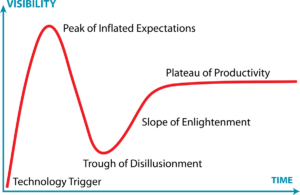SUSTAINABILITY – ALL HYPE?
by: Jeff Crissinger, VP of Agronomy Sales/Marketing
The “Gartner Hype Cycle” is a graphical representation that shows the typical path of emerging technologies or concepts starting from introduction through maturation.
THERE ARE FIVE GENERAL PHASES:
1. Introduction – a new technology or concept triggers significant publicity and attention, but often no usable product exists.
2. Inflated Expectations – expectations outpace the ability to execute on the promise, causing more failures than successes.
3. Disillusionment – Interest slows and some companies offering the technology or working on the concept exit the marketplace. Survivors continue to improve their positions through added development.
4. Enlightenment – The introduced technology or concept becomes more understood, true value propositions begin to appear, and 2nd or 3rd generation products begin to be offered.
5. Productivity – The technology or concept begins to clearly pay off, and mainstream adoption starts to grow.
Where would you put the sustainability push over the last couple of years on the cycle? It wasn’t that long ago that all of the talk was around collecting carbon credits and reselling them in the marketplace to create another source of revenue for the farmer, but how much have you heard of that recently? Has the hype seemed to slow down a little?
The recent interest in sustainability and its affiliated concepts are definitely following the Hype Cycle, so even though it may seem like interest is fading a little bit, it is important to know that there are opportunities yet to come as we move through Phase 3 and toward Phase 4. See graphic below.
Phase 4 is just beginning. We are now starting to see sustainability-based opportunities begin to develop in our local area in the form of grain premiums, and even though they may not seem like large opportunities right now, the point is that they have started.
The carbon industry is getting more sophisticated, and while the carbon credit market is still a discussion point, we are also starting to talk more about carbon intensity, which is a measure of how “clean” a product is produced. In agronomy, this concept allows growers to gain financial benefits for how they grow their crops.
The biggest benefit of a carbon intensity program is that you can gain credit for things you already do that are sustainable, and if you choose to integrate additional sustainability practices, you can gain even more financial benefit.
Eventually carbon intensity and carbon credits tie together and drive additional sustainability adoptions. For example, let’s say a grower has a base carbon intensity score and is receiving financial benefits for doing a few practices that qualify for a premium on grain. If that grower chooses to implement additional sustainability practices, they get a larger premium on their grain as an incentive. As the grower adopts those additional practices to gain additional premium, now they also start creating carbon credits, which can be sold to create compounded financial benefits.
Can you see the change coming? The sustainability effort has not gone away. It might be a little quieter right now, but it continues to grow stronger. There are a lot of technologies that are going to tie together to reinforce sustainability and drive it to become mainstream. Selective spraying, strip till, nitrogen modeling, short corn, cover crops and data management services are examples of opportunities out there that will work together to create a more sustainable system, providing added benefits to the customer and the environment. NuWay-K&H Cooperative continues to prepare for the future of sustainability and align us with the products and services that will make it possible for our growers to capitalize on these future opportunities. Are you ready?
THE HYPE CYCLE

Learn more about the NuWay-K&H agronomy team here.


